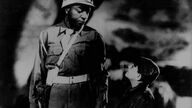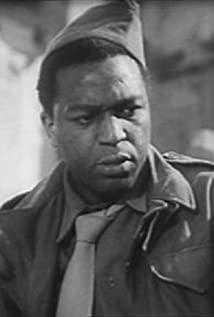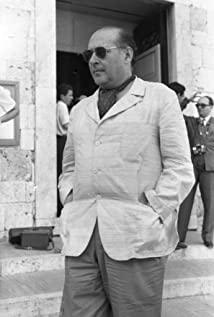Roberto Rossellini's Paisan [Italy 1946] surpasses his Open City [Italy 1945] in breadth of vision and significance. Open City was still a drama; Paisan is an epic, comparable only to [The Battleship] Potemkin [USSR 1925, dir. Sergei Eisenstein ], though profoundly different from it.
This new Italian film consists of six real-life episodes which take place during the Italian Campaign. They seem entirely unconnected, except for the fact that their succession corresponds to the advance of the Allied armies. The first episode records the adventures of an American patrol immediately after the landing in Sicily. Led by an Italian peasant girl, the Americans explore a ruined castle—a nocturnal reconnaissance which culminates in a magnificent conversation between the girl and one of the soldiers. But this bilingual idyll does not last long. A few Germans emerg- ing from nowhere shoot the soldier and then kill the girl for having fired at them. When, alarmed by the shooting, the rest of the Americans return, they take it for granted that the girl has lured them into a trap, and her simple-hearted sacrifice passes unnoticed.
The second episode, in Naples, features a street urchin and a Military Policeman—an American Negro who is thoroughly drunk. The boy, set on stealing the Negro's shoes, guides him to a rubble heap among the ruins, where his prospective victim raves about the hero reception prepared for him in New York and his home town. But the word “home” provokes a sudden shift of moods in him. He says he will not go home; and in a state of despondency he falls asleep, an easy prey for the boy. Shortly later, the Negro captures the thief and makes him return the shoes. The boy is a war orphan living in a cave crammed with ragged women and children. Overwhelmed by pity, the Negro leaves the shoes behind in the cave. Colorful street incidents round out the brilliant thumbnail sketches of these two stray creatures.The scene in the marionette theatre in which the frantic Negro climbs the miniature stage to defend a Moor is a veritable gem sparkling with Quixotic spirit.
The subsequent Roman episode is a somewhat literary love story, with a touch of Maupassant. Six months after the fall of Rome a drunken Ameri- can soldier follows a prostitute to her room. He is no drunkard but a sensi- tive boy appalled by the ever-increasing corruption around him. Instead of simply sleeping with the girl, he tells her about Francesca, the first girl he met on entering Rome on the day of liberation. A flashback, rich in charming details, renders their innocent flirtation and its premature end. Why did you never go back, asks the prostitute. He mutters that he could not find the house. The prostitute, trembling, describes it. He dozes off, vaguely realizing her identity. Next day, she despairingly waits for him, while he himself, on the point of leaving, tears up the slip of paper with her address. He mounts a truck,and the armies move on.
The fourth episode shows the Allies in the outskirts of Florence, pre-paring the last assault on the city, in which the Partisans are already at grips with the Germans and Fascists. An American nurse, eager to join her Florentine lover of prewar days, learns that he is “Lupo,” the legendary Partisan leader. The whole is a pictorial report on what happens to her and an Italian friend as they slip through the front lines into the Partisan-held sector of Florence. They walk past two British officers , portrayed in all their languid fastidiousness; they pass along the corridors of the abandoned Uffizi, catching a glimpse of three German soldiers who slowly advance deep down on the street. When they finally reach a bullet-swept street corner, one of the few Partisans defending this position is fatally wounded.His comrades liquidate two Fascists on the spot. Before dying in the arms of the nurse, the wounded Partisan says that Lupo has been killed that very morning. “God,” says the nurse.
In the fifth episode three American chaplains in search of shelter enter a remote Franciscan monastery in the Apennines and are accommodated there for the night. The naive unworldliness of the monks is characterized in scenes born out of respect and highlighted by an imperceptible smile. No sooner do the monks find out that one of their guests is a Protestant and the other a Jew than they involve the Catholic chaplain in a sort of religious disputation. Thesis stands against thesis: the worried monks insist that those two lost souls must be saved, while their urbane coreligionist believes them able to attain a state of grace outside the Church. This duel in pious dialectics is the more exquisite since battles are raging in the neighborhood. The end comes as a surprise.The zealous monks impose a fast on themselves for the sake of the Jew and the Protestant, and the Catholic chaplain praises their humility, instead of reaffirming his stand on tolerance. It is a strange conclusion, somewhat reminiscent of the spiritual note in Silone's novels. 1
The last episode is a terrible nightmare unfolding in the marshes of the Po Valley, where flat land and sky fuse into a monotonous universe. A small group of Italian Partisans, British flyers, and American OSS agents engage in a hopeless combat action behind the enemy lines. You do not see the Germans at first; you see only the corpse of a Partisan floating across the water. The reeds are filled with threats; unknown dangers lurk around the lonely house which in its isolation deepens the impression of monotony. Then, after an eternity of unbearable suspense, the massacre takes its course. The people in the house are killed indiscriminately, except for a little child who, outside the house, screams and screams, deserted by the dead on the ground. The Partisans, bound hand and foot, are thrown into the water.The horrified English and American prisoners see them, one by one, disappear, unable to stop the clockwork process. Another witness is left: the Partisan leader hanging behind the prisoners.
“This happened in the winter of 1944,” a commentator says at the very end. “A few weeks later, spring came to Italy and the war in Europe was declared over.”
All these episodes relate the experiences of ordinary people in a world which tends to thwart their noblest efforts. The dead Sicilian girl is cal- lously slandered by those who should have honored her; Francesca, the fresh Roman girl, turns prostitute, and her decent lover sinks into emo- tional inertia. It is the war which dooms them. Yet it is not always the war: in the case of the Negro, his fate results from circumstances entirely unconnected with events in Italy.
What endears these people to us is their inborn dignity. They have dignity in the same way that they breathe or eat. Throughout the film, humanity appears as a quality of man's nature, as something that exists in him independently of his ideals and creeds. Rossellini's Partisans never refer to their political convictions; rather, they fight and die in a matter-of-fact way, because they are as they are. And the Negro is simply a humane creature, filled with compassion, love of music, and Quixotic revisions.
This emphasis on the reality of good nature is coupled with a marked indifference to ideas. Of course, the Nazis appear as hateful, but it seems they are hated only for their acts of savagery and their vulgar conduct. All judgments are concerned with human dignity , and what goes beyond it is completely omitted. There is in the whole film not a single verbal statement against Fascist rule, nor any message in favor of democracy, let alone a social revolution. And the surface impression, that Paisanadvo- cates pacifism, must be dismissed also, for it is scarcely compatible with the experience of the Catholic chaplain, to whom the war has been a great lesson in tolerance. This deliberate disregard of all “causes,” including that of humanity, can be explained only by a profound skepticism about their effects. Even the most praiseworthy cause, Paisan implies, is bound to entail fanaticism, corruption, and misery, thus interfering with the free flow of a good and meaningful life. Significantly, the Sicilian peasants are suspicious of American liberators and German invaders alike; and the Roman episode bears out their suspicions by highlighting the demoraliza- tion wrought upon the liberated in less than six months.
The attitude behind Paisan is in keeping with the film's episodic struc- ture. In stringing together six separate episodes, Rossellini manifests his belief in the independence of human dignity from any overarching idea. If humanity materialized only under the guidance of an idea, then a single, well-composed story might suggest itself to express the latter's significance (viz. Potemkin ). But humanity is here part and parcel of reality and there- fore must be traced in various places. The six isolated episodes indicate that streaks of it are found everywhere.
Since Paisan confines itself to real-life experiences, its documentary style is most adequate. The style, cultivated by DW Griffith, Flaherty, and the Russian film directors, is genuinely cinematic, for it grows out of the urge, inherent in the camera, to explore the world of facts. Like Eisenstein or Flaherty, Rossellini goes the limit in capturing reality. He shoots on location and prefers laymen to professional actors. And instead of working from an elaborate script, with each detail thought out in advance, he lets himself be inspired by the unforeseeable situations that arise in the process of filming.
These techniques become virtues because of Rossellini's infatuation with reality and his gift for translating its every manifestation into cin- ematic terms. He masters horror scenes no less expertly than moments of tenderness, and the confused street crowd is as near to him as is the abandoned horror scenes individual in it. His camera angles and twists of action owe their existence to sparks of intuition ignited by the closest touch with the given material. And directed by him, most people play themselves without seeming to play at all. To be sure, Paisanhas its weak spots: parts of the Sicilian episode are shot in slapdash fashion; the Roman love story is too much of a story; the nurse and her companion in the Florentine episode are strangely flat; and the Catholic chaplain is not entirely true to type . But these occasional lapses amount to little within a film which sets a new pattern in documentary treatment. Its wonderful freshness results from Rossellini's unflinching directness in formulating his particular notion of humanity. He knows what he wants to say and says it as simply as possible .
Are examples needed? Far from capitalizing, after the manner of The Last Chance [USA 1945, dir. Leopold Lindtberg], on bilingual dialogue to sell the idea of international solidarity, Paisan presents the mingling of lan- guages in wartime Italy without any purpose . In the opening episode, the conversation between the Sicilian girl and the American soldier in charge of her is a linguistic dabbling which, born out of the latter's boredom and loneliness, does not lead up to anything. Yet precisely by recording their pointless attempts at Mutual understanding with infinite care, Rossellini manages to move and fascinate us. For in the process these two people, left speechless by their mother tongues, increasingly reveal what as a rule is buried under conventional phrases.
Each episode abounds in examples. When the drunken GI tells the Roman prostitute about his yearning for Francesca, he is seen lying on the couch, with his legs apart in the foreground—a shot which renders his physical disgust and moral disillusionment to perfection. Though long shots are ordinarily less communicative than close shots, Rossellini draws heavily on them in the last episode to picture the marshes. He does so on purpose, for these shots not only convey the impression of desolate monotony, but, through their very flatness, they make the ensuing mas- sacre seem more dreadful. A model of artistic intelligence are the street scenes in the Neapolitan episode. First it is as if these loosely connected shots of performing jugglers, ragged natives, blackmarketing children, and idling GI's were inserted only in the interest of local color.Shortly, however, it becomes evident that they also serve to characterize the Negro. As he reemerges from the marionette theatre, his companion, the wily boy who does not want to lose him, begins to play a harmonica; and, enticed by these heavenly sounds, the Negro follows the little Pied Piper through streets teeming with the crowds and diversions that have already been impressed upon us. So we are all the more struck by the impact of the trickling harmonica music on the Negro.the Negro follows the little Pied Piper through streets teeming with the crowds and diversions that have already been impressed upon us. So we are all the more struck by the impact of the trickling harmonica music on the Negro.the Negro follows the little Pied Piper through streets teeming with the crowds and diversions that have already been impressed upon us. So we are all the more struck by the impact of the trickling harmonica music on the Negro.
This last example well illustrates the way Rossellini organizes his mate- rial. There is a veritable gulf between his editing style and the “montage” methods used in Potemkin and other early Soviet films. For Rossellini deliberately turns his back on ideas, while the Russian film directors aim exclusively at driving home a message. Paisan deals with the human assets of ordinary people; Eisenstein's Potemkin shows ordinary people wedded to the cause of revolution. All editing devices in the Eisenstein film are calculated not only to render a historic uprising, but to render it in the light of Marxist doctrine. In Potemkin,the priest's face, besides being his face, stands for Tsarist oppression, and the sailors are made to appear as the vanguard of the proletariat. Nothing of that kind occurs in the Italian film. On the contrary, Rossellini so composes his narrative that we never feel challenged to seek symbolic meanings in it. Such instances of oppres- sion or humanity as Paisanoffers are strictly individual facts which do not admit of generalization. Rossellini patiently observes where Eisen-stein ardently constructs. This accounts for the thrill of a few shots which represent border cases. I am thinking in particular of the documentary shot of the three German soldiers in the Florentine episode. Reminiscent, perhaps deliberately so, of similar shots in official Nazi documentaries, it is inserted in such a manner that it affects us as a true revelation of German militarism. The allusiveness of this shot is sufficiently strong to drive us beyond the bounds of immediate reality, and yet too unobtrusive to make us lose contact with it.
Paisan is all the more amazing as it defies the traditional patterns of film making in Italy. The Italian prewar screen was crowded with historical extravaganzas and beautifully photographed dramas that displayed inflated passions before decorative settings—a long progression of glossy products, led by d' Annunzio's world-famous Cabiria, of 1914. Taking advantage of their audience's love for theatrics, these films reflected both the glitter and the hollowness of the regime under which they flourished. . . . It is a far cry from d'Annunzio to Rossellini, from the spectacular to the real. The sudden emergence of such a film as Paisanindicates that many Italians actually loathe the grand-style manner of the past and all that it implied in allegiances and sham beliefs. They have come to realize the futility of Mussolini's conquests and they seem now determined to do without any messages and missions—at least for the moment.
And this moment is a precarious one for the Italians. Fascist rule has ended, the new government is weak, and the country resounds with inter- nal strife. During this interregnum the Italians might feel completely lost, were it not for a compact cultural heritage which protects them from dis- integration. Theirs is an articulate sense of art and a tested way of putting up with the tragedies common to mortals. And under the undimishing spell of custom they knowingly enjoy the rites of love making and the gratifications of family life . No doubt, the Church has played its part in shaping and civilizing these people throughout the ages. That they are aware of it perhaps accounts for the surprise ending of the Monastery episode in Paisan—that scene in which the American chaplain bows to the religious ardor of the Italian monks, thus disavowing what he has said about the inclusiveness of true tolerance shortly before. His deliber- ate inconsistency can be considered a tribute to Italian Catholicism and its humanizing effects .
Italian everyday life, then, is rich in meaningful outlets for all imagin- able needs and desires. So the Italians do not sink into a vacuum when they refuse, as they are now doing, to let themselves be possessed with ideas. Even without ideas they still have much to rely upon. And since their kind of existence, mellow and sweet as it is, has long since become second nature to them—something that seems to them as natural as the blue sky or the air they breathe—they may well believe that their repudiation of ideas relieves their lives of excess baggage. What remains, in their opinion, is humanity, pure and simple. And in their case, as Paisan demonstrates, humanity assumes all the traits of self-sufficient reality.
This is a mirage, though, which may appear as more than a mirage only at a very particular moment, such as the Italians are now going through. Paisan is delusive in that it virtually makes the triumph of humanity dependent on a world released from the strain of ideas, or “causes.” We cannot feel this way. As matters stand, we know humanity would be irre- trievably bogged down if it were unsustained by the ideas mankind breeds in desperate attempts to improve its lot. Whatever their consequences, they hold out a promise to us. Rossellini's film dismisses the audience without any such promise. But this does not invalidate its peculiar greatness. And precisely in these postwar years with their tangle of oblique slogans and propaganda artifices, Paisancomes to us as a revelation of the steady flow of humanity beneath the turmoil of sheer ideology. So, if Paisan does not kindle hopes, yet it reassures us of the omnipresence of their sources.
Original source: Siegfried Kracauer's American Writings Essays on Film and Popular Culture
Paisan (1948) P156
View more about Paisan reviews











